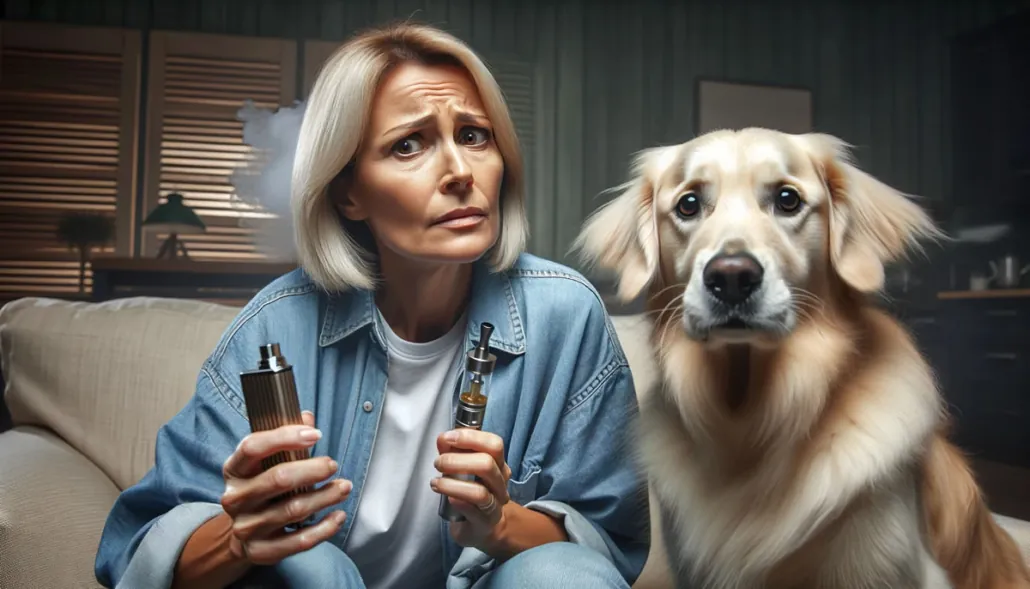Are Dogs Allergic to Vapes? Secondhand Exposure Risks
As vaping gains popularity as an alternative to traditional smoking, pet owners are growing increasingly concerned about the potential effects of secondhand vape exposure on their furry companions. While research on the long-term impact of vaping on human health continues, it’s crucial to consider how this habit might affect our dogs. In this comprehensive guide, we’ll explore the risks associated with exposing dogs to secondhand vape smoke, the signs of allergic reactions, and the steps pet owners can take to ensure a safe and healthy environment for their four-legged family members.
The Composition of Vape Smoke and Its Potential Effects on Dogs
Understanding the Ingredients in Vape Liquids
To grasp the potential risks vaping poses to dogs, it’s essential to understand the composition of vape liquids. Most e-liquids used in vaping devices, including popular disposable vapes, contain a combination of ingredients that can be harmful to dogs when inhaled:
- Propylene Glycol (PG): This odorless, colorless liquid is commonly used in vape liquids to create the vapor effect. While generally considered safe for human consumption, PG can be an irritant to dogs’ respiratory systems when inhaled in high concentrations.
- Vegetable Glycerin (VG): Another base ingredient in vape liquids, VG is a clear, odorless liquid derived from vegetable oils. Although VG is generally considered safe for dogs, excessive inhalation of VG-containing vapor is not recommended, as it may lead to respiratory irritation.
- Flavorings: Vape liquids come in a wide range of flavors, from fruity to dessert-inspired. These flavors are created using various chemical compounds, some of which can be toxic to dogs if inhaled or ingested.
- Nicotine/Cannabinoids: Many vape liquids contain nicotine, which is highly toxic to dogs. Even small amounts of nicotine can cause symptoms such as vomiting, diarrhea, and respiratory distress in dogs. Similarly, vape liquids containing cannabinoids like THC can be particularly harmful to dogs, leading to serious health issues.
Comparing Vape Smoke to Cigarette Smoke
While vape emissions generally contain fewer toxins than traditional cigarette smoke, they are not harmless to dogs. Secondhand cigarette smoke has been shown to increase the risk of respiratory issues, allergies, and even certain cancers in pets. Although the long-term effects of secondhand vape exposure on dogs are still being studied, it’s essential to minimize their exposure to any type of smoke or vapor to prioritize their health and well-being.

Recognizing the Signs of Allergic Reactions in Dogs to Vape Smoke
Common Symptoms of Vape-Related Allergies
Pet owners should be vigilant for signs of allergic reactions in their dogs after exposure to secondhand vape smoke. These symptoms can range from mild to severe and may include:
- Itchy, red, or moist skin
- Excessive scratching, biting, or chewing of the skin
- Runny eyes or nose
- Sneezing
- Vomiting or diarrhea
- Snoring caused by an inflamed throat
If you notice any of these symptoms, especially if they persist or worsen after exposure to vape smoke, it’s crucial to consult your veterinarian for an accurate diagnosis and appropriate treatment.
When to Seek Veterinary Care
In some cases, a dog’s reaction to vape smoke exposure can be severe and require immediate veterinary attention. If your dog exhibits any of the following symptoms after being around vape smoke, seek emergency care without delay (Bates, 2020):
- Respiratory distress (difficulty breathing, wheezing, or coughing)
- Persistent vomiting or diarrhea
- Seizures
- Collapse or unconsciousness
Your veterinarian may recommend treatments such as gastrointestinal decontamination, oxygen therapy, or other supportive care depending on the severity of the exposure and your dog’s symptoms.
Preventive Measures to Protect Dogs from Secondhand Vape Exposure
Creating a Vape-Free Environment for Your Dog
The most effective way to protect your dog from the potential risks of secondhand vape exposure is to create a vape-free environment in your home. This can involve:
- Designating specific areas for vaping that are well-ventilated and away from your dog’s living spaces.
- Using air purifiers with HEPA filters to reduce airborne contaminants.
- Regularly cleaning and vacuuming to remove any residual particulate matter.
- Keeping windows open when possible to allow for fresh air circulation.
Safe Vaping Practices for Pet Owners
In addition to creating a vape-free environment, pet owners who choose to vape can take several precautions to minimize the risk of secondhand exposure for their dogs:
- Always vape outdoors or in a well-ventilated area, away from your pet.
- Store vaping devices and e-liquids securely out of your dog’s reach to prevent accidental ingestion.
- Thoroughly wash your hands after vaping to remove any residual e-liquid that could be harmful if your dog licks your hands.
- Be mindful of any signs that your dog may be affected by secondhand vape smoke, such as coughing or wheezing, and consult your veterinarian if you notice any unusual symptoms.
Alternative Nicotine Delivery Methods for Dog Owners
For pet owners who are looking to quit vaping or minimize their dog’s exposure to secondhand vapor, there are several alternative nicotine delivery methods to consider:
- Nicotine replacement therapies (NRTs): Products such as nicotine patches, gum, or lozenges can help manage cravings without producing vapor that could harm your dog.
- Prescription medications: Under the guidance of a healthcare provider, prescription medications like varenicline or bupropion can be effective tools for quitting vaping.
- Behavioral support: Engaging in counseling or support groups can provide valuable strategies and encouragement for quitting vaping and protecting your pet’s health.

Ecigator Sticky Open Pod Kit
The Sticky Open Pod Kit is a contemporary vaping device that combines functionality with fashion. This kit is designed with a box-style form factor, offering a compact and stylish appearance that’s ideal for vaping enthusiasts on the move.
At the heart of this kit is a Refillable Open Pod System, with a capacity of 2ml, perfect for accommodating a variety of e-liquids. The pod is equipped with a high-quality Mesh Coil that not only ensures a rich and flavorful vaping experience but also boasts durability for up to 8 Refills.
Also Read:
THE ULTIMATE GUIDE TO NICOTINE POUCHES
Conclusion
As the popularity of vaping continues to rise, it’s crucial for pet owners to be aware of the potential risks secondhand vape exposure poses to their dogs. By understanding the composition of vape smoke, recognizing the signs of allergic reactions, and taking preventive measures to create a vape-free environment, dog owners can help protect their furry friends from the harmful effects of secondhand vapor.
If you suspect your dog has been exposed to vape smoke and is experiencing any concerning symptoms, don’t hesitate to seek veterinary care. Prioritizing your pet’s health and well-being is an essential part of being a responsible dog owner in the era of vaping.
Call to Action: Share this information with fellow pet owners to help spread awareness about the risks of secondhand vape exposure for dogs. Together, we can create safer, healthier environments for our furry friends.
- UK Wolverhampton Extends “Swap to Stop” Vape Program - July 4, 2025
- Pakistan Halts Vape Crackdown Pending Legislation - July 4, 2025
- Wisconsin New Law Banning Sale of Most Vape Products - July 4, 2025









